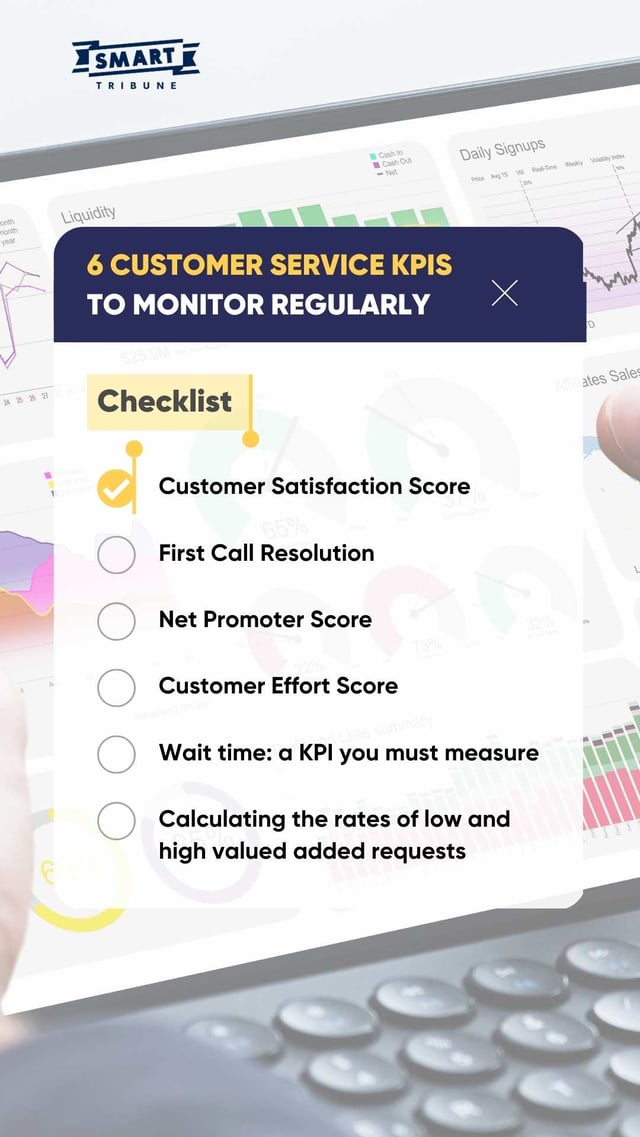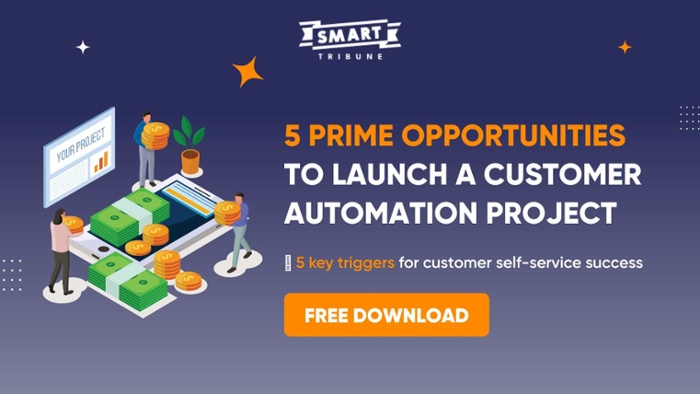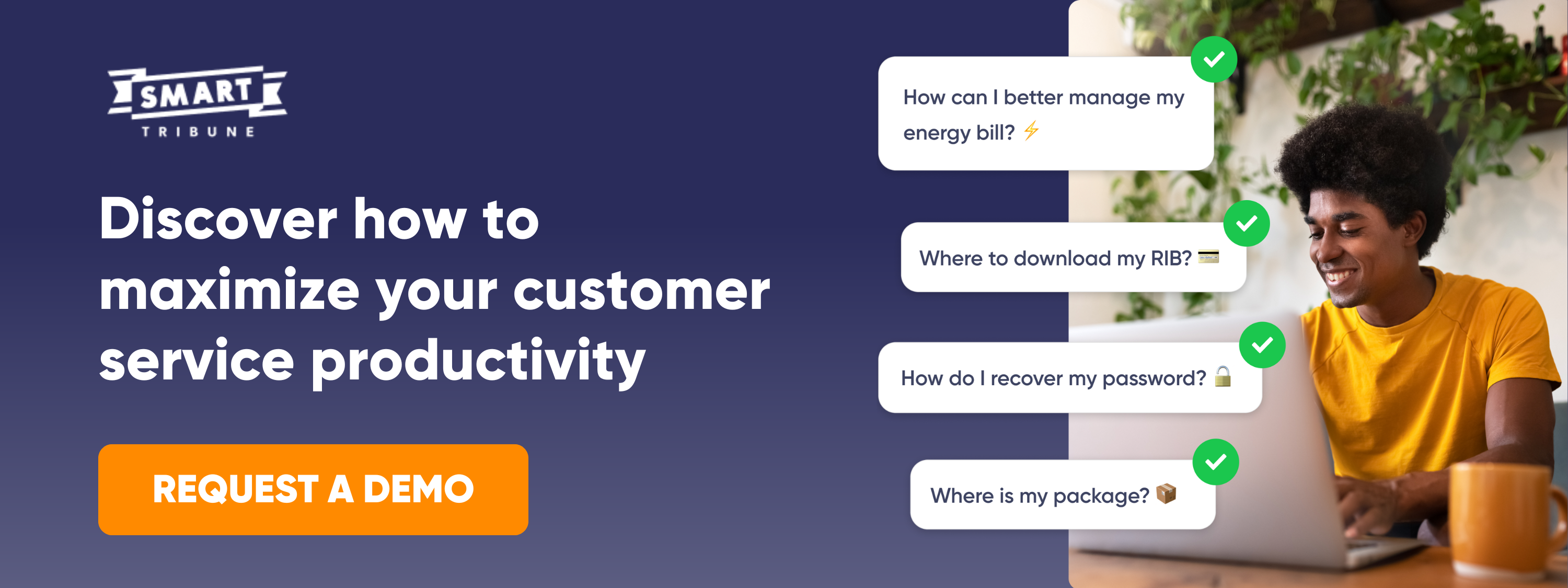
In terms of customer relations management as with everything, steering blindly is not the recommended strategy for those aiming for excellence!
In order to optimise your customer satisfaction rate and the use of your human resources, it is absolutely vital to rely on a precise list of customer service performance indicators, or KPIs (key performance indicators).
But what are the relevant units of measurement for a customer relations director? Below, you’ll find a quick overview of the 6 KPIs to monitor regularly for your customer service.
Why is it important to monitor the right KPIs for your customer service?
Dashboards and performance indicators are very practical tools. They allow you to transform customer satisfaction goals set by the company’s leaders into quantifiable and concrete data.
It sounds obvious but it isn’t for everyone; we know that 1 out of 4 of companies don’t measure the performance of their agents.
Good KPIs for customer service are also invaluable when it comes to observing, in real time, the positive or negative impact of your initiatives. Measuring the performance of your call centres will give you a more objective idea of their strengths and weaknesses.
How to design a usable customer service KPI?
Customer service indicators, and really any KPI, needs to have a few essential qualities: The data collected needs to be:
- Descriptive: your indicator needs to cover a simple notion and its content can’t be up for interpretation
- Specific: avoid catchall indicators; one measurement = one indicator
- Immediate: your indicator needs to be powered and updated regularly to provide real operational relevance. Otherwise, what’s the point?
- Authentic: Don’t create an indicator based on weak statistical resources.
It’s difficult to define any precise KPI for customer service because it’s subject to numerous variables: how the customer is feeling; what’s happening around them; the depth of the issue they’re facing; the pressure they’re under; exterior factors like budget, etc.
It’s also very important to remember that all KPIs are not equal and don’t have the same objectives! They have different goals. Understanding and interpreting KPIs is part of the day to day of customer service and marketing and requires ongoing data analysis efforts.
Customer satisfaction is often underestimated in terms of KPI analysis in a company. Satisfying customer needs pre-and post-purchase is often ignored. If you haven’t already, set up the monitoring of these 6 KPIs that will allow you to better keep an eye on your customer relations on an ongoing basis and to integrate them into your customer service roadmap!
6 priority customer service KPIs to monitor regularly

1. Customer Satisfaction Score: Measuring customer satisfaction
The first KPI for customer service that you should know is measuring customer satisfaction. It indicators are among the most basic KPIs available to a customer service director, but they are also among the most diverse.
The challenge consists of determining what approach will help you achieve a high rate of satisfied customers (automatic email after the resolution of an issue, questions asked by the agent, etc.).
Based on a LogMeIn et Ovum study, 85% of customer relations agents in direct contact with customers have expressed a very high level of frustration because they have not been able to respond fully to the expectations of very demanding customers.
The Customer Satisfaction Score (CSAT) is a classic and a necessity when it comes to measuring satisfaction in the short term.
- “Are you satisfied?”
This question is asked in a general way after a customer service experience or after the use of a product. The response can be “yes” or “no,” or a number between 1 (not at all satisfied) and 5 (very satisfied).
To conduct a more detailed analysis, offer your consumers the option to comment on several key criteria. This will allow you to identify in real-time any unsatisfied customers and to correct the situation before it grows.
This KPI allows you to protect your reputation. It’s a simple KPI that’s beneficial in order to reach a 70% satisfaction rate.
2. First Call Resolution: Evaluating the resolution rate after first contact
Based on a LogMeIn et Ovum study, 85% of customer relations agents in direct contact with customers have expressed a very high level of frustration because they have not been able to respond fully to the expectations of very demanding customers.
First Call Resolution (FCR) is the rate of resolution at first contact, which often quite clearly reflects the performance of customer service agents and also the difficulties they may face despite their goodwill. There is a correlation between FCR and CSAT.
A study conducted by Customer Relationship Metrics showed that a CSAT will be 35%-45% lower if a second call is needed to resolve an issue. Another study by the Service Quality Measurement Group revealed that with each 1% improvement in FCR, you can increase your CSAT by 1%.
Even if a low rate can be connected to a redirection of your agents’ work toward high valued-added requests, it’s better to spend time resolving issues than to neglect them.
- Your customer will feel more considered.
3. Net Promoter Score: measuring loyalty
Created in 2003, the Net Promoter Score (NPS) focuses on the measurement of more long-term satisfaction, notably in terms of loyalty.
Compared to the CSAT, the NPS is a better indicator for predicting your consumer’s behavior and is often linked to the measurements of company growth.
“What is the probability that you would recommend this product/brand?”
The response is given on a scale of 0 (not at all likely) to 10 (highly likely). The questions allows you to situate your customers in a certain NPS segment (Promoters, Passive, Detractors). Just like with the CSAT, asking supplemental qualitative questions can help identify reasons why they would or wouldn’t recommend you.
The NPS gives you a good picture of your customers’ attachment to your product or brand. The Advocacy Drives Growth study conducted by the London School of Economics showed that a 7% increase in NPS can lead to a 1% increase in sales.
More B2C-oriented, the NPS allows you to link customer relations metrics with the company’s financial performance.
4. Customer Effort Score: Measuring the level of effort made
Having appeared in 2010, the Customer Effort Score (CES) also measures satisfaction but in regards to the effort linked to the customer journey.
In general, it’s recommended to conduct surveys right after the customer experience to avoid your customer forgetting their experience.
The CES allows you to identify at which step in the customer journey the effort increases.
“What level of effort did you have to make in order for your request to be treated?”
The response is given from 1 (low level) to 5 (high level). Always with an eye towards understanding why the customers feel they need to make a big effort, add an open-ended question.
This customer feedback will allow you to categorise your efforts base on different types, for example:
- insisting in order to solve a problem
- re-explaining the situation to a different agent
- being transferred nonstop from one service to another
- recontracting the company multiple times.
In a study conducted by the Harvard Business Review (Matthew Dixon, Karen Freeman and Nicholas Toman), 94% of customers who have claimed a low effort are ready to purchase again and 88% affirm being ready to increase their spending.
However, 81% of consumers who’ve spent intense effort emphasise an intention to speak poorly about their experience.
5. Wait time: a KPI you must measure
Among the main customer service performance indicators, wait time is the one that will give you the best overview of the overall quality of your customer service. It will also indicate whether your resources meet the needs of your customers.
By phone, for example, you’ll find two types of wait times: before getting an agent on the line and before resolving the issue.
The average resolution time includes the necessary time to treat a request. In the case of a phone call, you’ll need to add the wait time before getting an agent on the line, the length of the conversation, and also the time it takes after the call to treat the issue.
Reducing the average resolution time can be anti-customer-centric in that it can also impact the quality of the exchange. It is therefore interesting to work on the pickup time, which is where 3 out of 4 consumers lose patience (source: Eptica).
For an email or contact form, the wait time for a response is longer than for a call: On average, 24h for French companies. Keep in mind that the longer a customer waits, the more unhappy they’ll be. Availability and reactivity are the key words.
6 . Calculating the rates of low and high valued added requests
It’s important to reorganise requests based on two types: high- and low-value added.
The reason for measuring the numbers of these two types of requests is to evaluate if your customer service center brings real value.
If your agents are mostly overwhelmed by recurring and simple requests, you should restructure your customer self-service strategy to unclog it from these requests. This will allow your agents to spend time on requests that require a real personalised exchange, deep analysis and human thinking.
There are many digital and customer self-service tools like chatbots and FAQs that allow you to filter out low valued-added requests. Contact forms can also help streamline requests.
Basically, when a user writes their message in a contact form, Natural Language Processing (NLP) technologies can detect the issue and suggest questions and answers that are accessible from a knowledge base.
If the response already exists in your knowledge base and corresponds to the question, you’re saved from having to respond via email.
Customer relations KPIs bring together a large family of indicators that often reveal basic common sense for a professional who is careful about measuring team performance. It’s up to you to choose the right KPIs that will punctuate your customer service!



.png)



